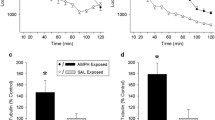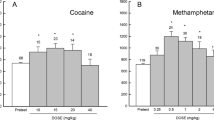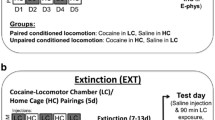Abstract
Rationale
Repeated exposure to psychostimulant drugs results in conditioned activity and behavioral sensitization. Nonassociative cellular changes are necessary for behavioral sensitization, while associative processes appear to modify the sensitized response.
Objective
The purpose of the present study was to determine whether the absence of the D1 receptor would disrupt associative processes modulating sensitization and conditioned activity.
Methods
Wild-type and D1 receptor knockout mice (i.e., D1-deficient mice) were injected with amphetamine (AMPH; 8 mg/kg, IP) before being placed in a previously novel test chamber (AMPH-Test group) or before being returned to the home cage (AMPH-Home group). Separate groups of mice were injected with saline (SAL) at the same time points. Distance traveled was measured 60 min each day, with the preexposure phase lasting 1 or 7 days. Sensitization was subsequently assessed after an injection of AMPH (1 mg/kg, IP), while conditioned activity was assessed after an injection of SAL.
Results
After a 1-day preexposure phase, wild-type and D1-deficient mice exhibited similar patterns of sensitization and conditioned activity. After a 7-day preexposure phase, (1) D1-deficient mice exhibited more robust context-specific sensitization than wild-type mice, (2) only D1-deficient mice showed context-independent sensitization, and (3) only D1-deficient mice showed conditioned activity.
Conclusions
Repeatedly treating D1-deficient mice with AMPH appears to cause a general increase in responsivity. The reason for this hyper-responsivity is uncertain, but it is possible that cues from the testing environment were unable to inhibit responding (i.e., associative processes were disrupted). Alternatively, compensatory mechanisms (e.g., increases in D2-like receptors) may affect processes underlying sensitization and conditioned activity.








Similar content being viewed by others

References
Adams JU, Careri JM, Efferen TR, Rotrosen J (2001) Differential effects of dopamine antagonists on locomotor activity, conditioned activity and conditioned place preference induced by cocaine in rats. Behav Pharmacol 12:603–611
Ahmed SH, Oberling P, Di Scala G, Sandner G (1996) Amphetamine-induced conditioned activity does not result from a failure of rats to habituate to novelty. Psychopharmacology (Berl) 123:325–332
Ahmed SH, Stinus L, Cador M (1998) Amphetamine-induced conditioned activity is insensitive to perturbations known to affect Pavlovian conditioned responses in rats. Behav Neurosci 112:1167–1176
Anagnostaras SG, Robinson TE (1996) Sensitization to the psychomotor stimulant effects of amphetamine: modulation by associative learning. Behav Neurosci 110:1397–1414
Anagnostaras SG, Schallert T, Robinson TE (2002) Memory processes governing amphetamine-induced psychomotor sensitization. Neuropsychopharmacology 26:703–715
Badiani A, Robinson TE (2004) Drug-induced neurobehavioral plasticity: the role of environmental context. Behav Pharmacol 15:327–339
Badiani A, Camp DM, Robinson TE (1997) Enduring enhancement of amphetamine sensitization by drug-associated environmental stimuli. J Pharmacol Exp Ther 282:787–794
Badiani A, Oates MM, Day HE, Watson SJ, Akil H, Robinson TE (1998) Amphetamine-induced behavior, dopamine release, and c-fos mRNA expression: modulation by environmental novelty. J Neurosci 18:10579–10593
Badiani A, Oates MM, Day HE, Watson SJ, Akil H, Robinson TE (1999) Environmental modulation of amphetamine-induced c-fos expression in D1 versus D2 striatal neurons. Behav Brain Res 103:203–209
Barr AM, Hofmann CE, Weinberg J, Phillips AG (2002) Exposure to repeated, intermittent d-amphetamine induces sensitization of HPA axis to a subsequent stressor. Neuropsychopharmacology 26:286–294
Battisti JJ, Chang CH, Uretsky NJ, Wallace LJ (1999) Sensitization of stereotyped behavior to amphetamine is context and response dependent. Pharmacol Biochem Behav 63:263–269
Battisti JJ, Uretsky NJ, Wallace LJ (2000) Importance of environmental context in the development of amphetamine- or apomorphine-induced stereotyped behavior after single and multiple doses. Pharmacol Biochem Behav 66:671–677
Bender M, Drago J, Rivkees SA (1997) D1 receptors mediate dopamine action in the fetal suprachiasmatic nuclei: studies of mice with targeted deletion of the D1 dopamine receptor gene. Mol Brain Res 49:271–277
Beninger RJ, Hahn BL (1983) Pimozide blocks establishment but not expression of amphetamine-produced environment-specific conditioning. Science 220:1304–1306
Berretta S, Robertson HA, Graybiel AM (1992) Dopamine and glutamate agonists stimulate neuron-specific expression of Fos-like protein in the striatum. J Neurophysiol 68:767–777
Browman KE, Badiani A, Robinson TE (1998a) Modulatory effect of environmental stimuli on the susceptibility to amphetamine sensitization: a dose-effect study in rats. J Pharmacol Exp Ther 287:1007–1014
Browman KE, Badiani A, Robinson TE (1998b) The influence of environment on the induction of sensitization to the psychomotor activating effects of intravenous cocaine in rats is dose-dependent. Psychopharmacology (Berl) 137:90–98
Carey RJ, Gui J (1998) Cocaine conditioning and cocaine sensitization: what is the relationship? Behav Brain Res 92:67–76
Centonze D, Grande C, Saulle E, Martin AB, Gubellini P, Pavón N, Pisani A, Bernardi G, Moratalla R, Calabresi P (2003) Distinct roles of D1 and D5 dopamine receptors in motor activity and striatal synaptic plasticity. J Neurosci 23:8506–8512
Clifford JJ, Tighe O, Croke DT, Sibley DR, Drago J, Waddington JL (1998) Topographical evaluation of the phenotype of spontaneous behaviour in mice with targeted gene deletion of the D1A dopamine receptor: paradoxical elevation of grooming syntax. Neuropharmacology 37:1595–1602
Crawford CA, Drago J, Watson JB, Levine MS (1997) Effects of repeated amphetamine treatment on the locomotor activity of the dopamine D1A-deficient mouse. Neuroreport 8:2523–2527
Crawford CA, McDougall SA, Meier TL, Collins RL, Watson JB (1998) Repeated methylphenidate treatment induces behavioral sensitization and decreases protein kinase A and dopamine-stimulated adenylyl cyclase activity in the dorsal striatum. Psychopharmacology (Berl) 136:34–43
Díaz-Otañez CS, Capriles NR, Cancela LM (1997) D1 and D2 dopamine and opiate receptors are involved in the restraint stress-induced sensitization to the psychostimulant effects of amphetamine. Pharmacol Biochem Behav 58:9–14
Drago J, Gerfen CR, Lachowicz JE, Steiner H, Hollon TR, Love PE, Ooi GT, Grinberg A, Lee EJ, Huang SP, Bartlett PF, Jose PA, Sibley DR, Westphal H (1994) Altered striatal function in a mutant mouse lacking D1A dopamine receptors. Proc Natl Acad Sci U S A 91:12564–12568
Ferguson SM, Robinson TE (2004) Amphetamine-evoked gene expression in striatopallidal neurons: regulation by corticostriatal afferents and the ERK/MAPK signaling cascade. J Neurochem 91:337–348
Ferguson SM, Norton CS, Watson SJ, Akil H, Robinson TE (2003) Amphetamine-evoked c-fos mRNA expression in the caudate-putamen: the effects of DA and NMDA receptor antagonists vary as a function of neuronal phenotype and environmental context. J Neurochem 86:33–44
Fontana D, Post RM, Weiss SRB, Pert A (1993) The role of D1 and D2 dopamine receptors in the acquisition and expression of cocaine-induced conditioned increases in locomotor activity. Behav Pharmacol 4:375–387
Fowler SC, Birkestrand B, Chen R, Vorontsova E, Zarcone T (2003) Behavioral sensitization to amphetamine in rats: changes in the rhythm of head movements during focused stereotypies. Psychopharmacology (Berl) 170:167–177
Hamamura T, Fibiger HC (1993) Enhanced stress-induced dopamine release in the prefrontal cortex of amphetamine-sensitized rats. Eur J Pharmacol 237:65–71
Hamamura T, Akiyama K, Akimoto K, Kashihara K, Okumura K, Ujike H, Otsuki S (1991) Co-administration of either a selective D1 or D2 dopamine antagonist with methamphetamine prevents methamphetamine-induced behavioral sensitization and neurochemical change, studied by in vivo intracerebral dialysis. Brain Res 546:40–46
Handa RJ, Nunley KM, Lorens SA, Louie JP, McGivern RF, Bollnow MR (1994) Androgen regulation of adrenocorticotropin and corticosterone secretion in the male rat following novelty and foot shock stressors. Physiol Behav 55:117–124
Henry DJ, White FJ (1991) Repeated cocaine administration causes persistent enhancement of D1 dopamine receptor sensitivity within the rat nucleus accumbens. J Pharmacol Exp Ther 258:882–890
Henry DJ, White FJ (1995) The persistence of behavioral sensitization to cocaine parallels enhanced inhibition of nucleus accumbens neurons. J Neurosci 15:6287–6299
Jackson HC, Nutt DJ (1993) A single preexposure produces sensitization to the locomotor effects of cocaine in mice. Pharmacol Biochem Behav 45:733–735
Johansson B, Lindström K, Fredholm BB (1994) Differences in the regional and cellular localization of c-fos messenger RNA induced by amphetamine, cocaine and caffeine in the rat. Neuroscience 59:837–849
Kalivas PW, Stewart J (1991) Dopamine transmission in the initiation and expression of drug- and stress-induced sensitization of motor activity. Brain Res Rev 16:223–244
Karper PE, De La Rosa H, Newman ER, Krall CM, Nazarian A, McDougall SA, Crawford CA (2002) Role of D1-like receptors in amphetamine-induced behavioral sensitization: a study using D1A receptor knockout mice. Psychopharmacology (Berl) 159:407–414
Kuczenski R, Leith NJ (1981) Chronic amphetamine: is dopamine a link in or a mediator of the development of tolerance and reverse tolerance? Pharmacol Biochem Behav 15:405–413
Levine MS, Altemus KL, Cepeda C, Cromwell HC, Crawford C, Ariano MA, Drago J, Sibley DR, Westphal H (1996) Modulatory actions of dopamine on NMDA receptor-mediated responses are reduced in D1A-deficient mutant mice. J Neurosci 16:5870–5882
Mattingly BA, Gotsick JE (1989) Conditioning and experiential factors affecting the development of sensitization to apomorphine. Behav Neurosci 103:1311–1317
Mattingly BA, Hart TC, Lim K, Perkins C (1994) Selective antagonism of dopamine D1 and D2 receptors does not block the development of behavioral sensitization to cocaine. Psychopharmacology (Berl) 114:239–242
Mazurski EJ, Beninger RJ (1987) Environment-specific conditioning and sensitization with (+)-amphetamine. Pharmacol Biochem Behav 27:61–65
Mazurski EJ, Beninger RJ (1991) Effects of selective drugs for dopaminergic D1 and D2 receptors on conditioned locomotion in rats. Psychopharmacology (Berl) 105:107–112
Michel A, Tambour S, Tirelli E (2003) The magnitude and the extinction duration of the cocaine-induced conditioned locomotion-activated response are related to the number of cocaine injections paired with the testing context in C57BL/6J mice. Behav Brain Res 145:113–123
Miner LL, Drago J, Chamberlain PM, Donovan D, Uhl GR (1995) Retained cocaine conditioned place preference in D1 receptor deficient mice. Neuroreport 6:2314–2316
Moyaho A, Valencia J (2002) Grooming and yawning trace adjustment to unfamiliar environments in laboratory Sprague–Dawley rats (Rattus norvegicus). J Comp Psychol 116:263–269
Nikulina EM, Covington HE III, Ganschow L, Hammer RP Jr, Miczek KA (2004) Long-term behavioral and neuronal cross-sensitization to amphetamine induced by repeated brief social defeat stress: fos in the ventral tegmental area and amygdala. Neuroscience 123:857–865
Ostrander MM, Badiani A, Day HE, Norton CS, Watson SJ, Akil H, Robinson TE (2003) Environmental context and drug history modulate amphetamine-induced c-fos mRNA expression in the basal ganglia, central extended amygdala, and associated limbic forebrain. Neuroscience 120:551–571
Partridge B, Schenk S (1999) Context-independent sensitization to the locomotor-activating effects of cocaine. Pharmacol Biochem Behav 63:543–548
Pierce RC, Kalivas PW (1997) A circuitry model of the expression of behavioral sensitization to amphetamine-like psychostimulants. Brain Res Rev 25:192–216
Robinson TE, Becker JB (1986) Enduring changes in brain and behavior produced by chronic amphetamine administration: a review and evaluation of animal models of amphetamine psychosis. Brain Res Rev 11:157−198
Schmidt ED, Tilders FJ, Janszen AW, Binnekade R, De Vries TJ, Schoffelmeer AN (1995) Intermittent cocaine exposure causes delayed and long-lasting sensitization of cocaine-induced ACTH secretion in rats. Eur J Pharmacol 285:317–321
Smith DR, Striplin CD, Geller AM, Mailman RB, Drago J, Lawler CP, Gallagher M (1998) Behavioural assessment of mice lacking D1A dopamine receptors. Neuroscience 86:135–146
Steketee JD (2003) Neurotransmitter systems of the medial prefrontal cortex: potential role in sensitization to psychostimulants. Brain Res Rev 41:203–228
Stewart J, Vezina P (1988) Conditioning and behavioral sensitization. In: Kalivas PW, Barnes CD (eds) Sensitization in the nervous system. Telford, Caldwell, NJ, pp 207–224
Stewart J, Vezina P (1991) Extinction procedures abolish conditioned stimulus control but spare sensitized responding to amphetamine. Behav Pharmacol 2:65–71
Szechtman H, Talangbayan H, Eilam D (1993) Environmental and behavioral components of sensitization induced by the dopamine agonist quinpirole. Behav Pharmacol 4:405–410
Tirelli E, Terry P (1998) Amphetamine-induced conditioned activity and sensitization: the role of habituation to the test context and the involvement of Pavlovian processes. Behav Pharmacol 9:409–419
Tirelli E, Tambour S, Michel A (2003) Sensitised locomotion does not predict conditioned locomotion in cocaine-treated mice: further evidence against the excitatory conditioning model of context-dependent sensitisation. Eur Neuropsychopharmacol 13:289–296
Uslaner J, Badiani A, Norton CS, Day HE, Watson SJ, Akil H, Robinson TE (2001) Amphetamine and cocaine induce different patterns of c-fos mRNA expression in the striatum and subthalamic nucleus depending on environmental context. Eur J Neurosci 13:1977–1983
van Erp AM, Kruk MR, Meelis W, Willekens-Bramer DC (1994) Effect of environmental stressors on time course, variability and form of self-grooming in the rat: handling, social contact, defeat, novelty, restraint and fur moistening. Behav Brain Res 65:47–55
Vezina P (1996) D1 dopamine receptor activation is necessary for the induction of sensitization by amphetamine in the ventral tegmental area. J Neurosci 16:2411–2420
Vezina P, Stewart J (1989) The effect of dopamine receptor blockade on the development of sensitization to the locomotor activating effects of amphetamine and morphine. Brain Res 499:108–120
Vezina P, Stewart J (1990) Amphetamine administered to the ventral tegmental area but not to the nucleus accumbens sensitizes rats to systemic morphine: lack of conditioned effects. Brain Res 516:99–106
White FJ, Joshi A, Koeltzow TE, Hu X-T (1998) Dopamine receptor antagonists fail to prevent induction of cocaine sensitization. Neuropsychopharmacology 18:26–40
Wolf ME (1998) The role of excitatory amino acids in behavioral sensitization to psychomotor stimulants. Prog Neurobiol 54:679–720
Wong JY, Padungchaichot P, Massalas JS, Drago J (2000) Late direct and transneuronal effects in mice with targeted expression of a toxin gene to D1 dopamine receptor neurons. Neuroscience 95:1035–1041
Wong JY, Clifford JJ, Massalas JS, Finkelstein DI, Horne MK, Waddington JL, Drago J (2003) Neurochemical changes in dopamine D1, D3 and D1/D3 receptor knockout mice. Eur J Pharmacol 472:39–47
Xu M, Guo Y, Vorhees CV, Zhang J (2000) Behavioral responses to cocaine and amphetamine administration in mice lacking the dopamine D1 receptor. Brain Res 852:198–207
Acknowledgements
We thank Eva Newman for help with testing the animals. This work was partially supported by a grant from the National Institutes of Health (DA12169) to C.A.C. and an ASI research grant (CSUSB) to P.E.K.
Author information
Authors and Affiliations
Corresponding author
Rights and permissions
About this article
Cite this article
McDougall, S.A., Reichel, C.M., Cyr, M.C. et al. Importance of D1 receptors for associative components of amphetamine-induced behavioral sensitization and conditioned activity: a study using D1 receptor knockout mice. Psychopharmacology 183, 20–30 (2005). https://doi.org/10.1007/s00213-005-0146-9
Received:
Accepted:
Published:
Issue Date:
DOI: https://doi.org/10.1007/s00213-005-0146-9



